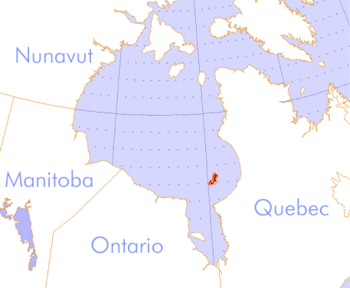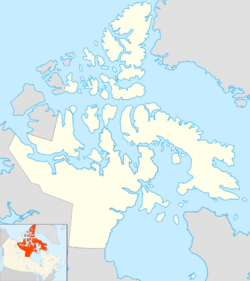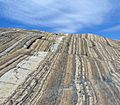Belcher Islands facts for kids
|
Native name:
Sanikiluaq
|
|
|---|---|

Belcher Islands, Nunavut (red).
|
|
| Geography | |
| Location | Hudson Bay |
| Coordinates | 56°20′N 79°30′W / 56.333°N 79.500°W |
| Archipelago | Belcher Islands Archipelago |
| Total islands | 1,500 |
| Major islands | Flaherty Island, Kugong Island, Tukarak Island, Innetalling Island |
| Area | 2,896 km2 (1,118 sq mi) |
| Administration | |
|
Canada
|
|
| Territory | Nunavut |
| Region | Qikiqtaaluk |
| Demographics | |
| Population | 882 (2016) |
| Pop. density | 0.30 /km2 (0.78 /sq mi) |
| Ethnic groups | Inuit |
The Belcher Islands (Inuktitut: Sanikiluaq) are a group of islands found in the southeast part of Hudson Bay. These islands cover a large area of almost 3,000 square kilometers. They are part of the Qikiqtaaluk Region in Nunavut, Canada. The small town of Sanikiluaq is located on the north coast of Flaherty Island. Most of the people living on the Belcher Islands call Sanikiluaq home. It is also the southernmost community in Nunavut.
Besides Flaherty Island, other big islands in this group of 1,500 islands include Kugong Island, Tukarak Island, and Innetalling Island. Some other important islands are Moore Island, Wiegand Island, Split Island, Snape Island, and Mavor Island. There are also groups of smaller islands like the Sleeper Islands, King George Islands, and Bakers Dozen Islands.
Contents
History of the Belcher Islands
Before 1914, maps didn't show the Belcher Islands very well. They looked like tiny dots, much smaller than they actually are. In 1914, a map drawn by George Weetaltuk was seen by Robert J. Flaherty. After that, mapmakers started drawing the islands more accurately. The islands are named after Admiral Sir Edward Belcher (1799-1877) from the Royal Navy.
In 1941, a sad event happened. A religious movement led by Charley Ouyerack, Peter Sala, and his sister Mina resulted in the deaths of nine people.
Geology: How the Islands Were Formed
The rocks that make up the Belcher Islands are very, very old. They were formed during a time called the Paleoproterozoic Era. This was about 2 billion years ago! These rocks are part of a larger group of ancient rocks found around the edge of the Superior Craton, which is a very stable and old part of the Earth's crust.
The different layers of rock in the Belcher Islands were formed over millions of years. Here are some of the main rock types, from the newest to the oldest:
- Loaf Formation: Rocks made from eroded material.
- Omarolluk Formation: Rocks formed from mud and sand in deep water.
- Flaherty Formation: Rocks from ancient lava flows.
- Kipalu Formation: Rocks rich in iron.
- Mukpollo Formation: Rocks made from sand.
- Rowatt Formation: Rocks formed in shallow ocean water.
- Laddie Formation: Deep ocean red-colored rocks.
- Costello Formation: Rocks formed on an underwater slope.
- Mavor Formation: Rocks made from ancient layered structures created by tiny living things called stromatolites.
- Tukarak Formation: Rocks formed in shallow ocean water.
- Fairweather Formation: Rocks formed in shallow ocean water.
- Eskimo Formation: Rocks from ancient lava flows.
- Kasegalik Formation: Rocks formed in salty, flat areas.
The oldest rocks in the Belcher Islands, the Kasegalik Formation, were laid down between 2.0185 and 2.0154 billion years ago. These rocks also contain the oldest clear signs of tiny, ancient life forms called Cyanobacteria. Many of the Belcher Islands' rock layers were formed in shallow water or areas where the tide goes in and out. However, some layers, like the Mavor Formation, were part of ancient reefs, and others, like the Costello and Laddie formations, were formed in deeper ocean areas.
The Flaherty Formation, which is made of basalt (a type of volcanic rock), forms a big part of the Belcher Islands. These rocks were laid down between 1.87 and 1.854 billion years ago.
Soapstone: A Special Rock
The Belcher Islands are known for having very good quality soapstone. This soft rock is important for local artists who carve beautiful sculptures from it. Soapstone formed when hot, melted rock (magma) pushed its way into the older sedimentary rocks of the Belcher Islands about 1.87 billion years ago.
Most of the soapstone comes from a site on western Tukarak Island. Here, a rock called dolomite reacted with other minerals and water under intense heat from the magma. This process created the soft, carvable soapstone. Other minerals found in the soapstone include calcite, dolomite, talc, and chlinochlore.
Even though most soapstone has come from two main quarries, there might be many more places on the islands where high-quality soapstone can be found.
Flora: Plants of the Islands
Several types of willow plants grow on the Belcher Islands. These small shrubs are a big part of the native plant life. Some types include rock willow (Salix vestita), bog willow (S. pedicellaris), and Labrador willow (S. argyrocarpa). There are also natural hybrids between S. arctica and S. glauca.
Trees generally cannot grow on the islands, except in some valley areas. This is because the soil is not deep enough to support them.
Fauna: Animals of the Islands
The main wildlife you can see on the Belcher Islands all year round includes belugas (a type of white whale), walruses, caribou (a type of deer), common eiders (a large sea duck), and snowy owls.
There are also many different kinds of fish that can be caught in the waters around the islands. These include Arctic char, cod, capelin, lump fish, and sculpin.
The special connection between the Sanikiluaq community and the eider ducks was even made into a Canadian documentary film called People of a Feather. The director, Joel Heath, spent seven years working on this project and also wrote scientific articles about the eider ducks.
In 1998, the caribou herd on the Belcher Islands (Rangifer tarandus groenlandicus) had about 800 animals.
Images for kids
See also
 In Spanish: Islas Belcher para niños
In Spanish: Islas Belcher para niños






